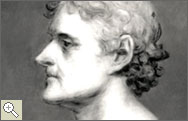|
|
 |
 |
 |
|
Sight Unseen |
|
Introduction
-
Sight Unseen
-
Land Made Real
-
Journey and Journals
-
Following the Trail
-
Timeline
|
 |
 |
 |

Jefferson was elected president in 1800, a year after Napoleon came to power and a month after France, having ceded the Louisiana Territory to Spain in 1762, regained it in the Treaty of San Ildefonso.
The Louisiana Territory comprised the Mississippi River system west of the river itself, some 820,000 square miles. It included the city of New Orleans, the great gateway of commerce between the West and the rest of the world. Jefferson had considered revolutionary France a "natural friend" of the United States, but the Treaty of San Ildefonso changed everything. Whoever controlled New Orleans stood in the way of American destiny in the West and was "our natural and habitual enemy."
Jefferson sent James Monroe to Paris to assist Robert C. Livingston, the American ambassador to France, in negotiations for the purchase of New Orleans. The French, faced with a costly war with Britain, made one of the most extraordinary counteroffers in history: they would sell the whole territory for some $15 million, or less than three cents an acre.
Jefferson and Merriwether Lewis, the president’s private secretary in the White House, began planning a western expedition long before this. In 1802, they both read the journals of a Scottish fur trader, Alexander Mackenzie, who had crossed Canada and reached the Pacific. Jefferson proposed an American "Voyage of Discovery" to Congress in January 1803.
The Louisiana Purchase was signed in April 1803, but the news from Paris did not reach the United States until the summer. By then, Lewis had already bought supplies and had ordered the construction of a fifty-five-foot keelboat. On July 5, he left Washington for Pittsburgh to take command of the boat. William Clark, his former superior officer in the army, joined him in the autumn at Louisville, Kentucky.
|
 |
 |
 |
 |

Thomas Jefferson by Charles Bird King, after Gilbert Stuart, 1836.
|
 |
 |

National Portrait Gallery, Smithsonian Institution.
|
 |
 |
 |
|




|
|
|

